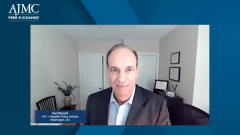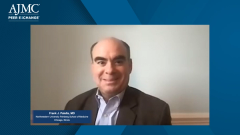
Role of USPSTF Guidelines for Access to HIV PrEP
Sean E. Bland, JD, reviews the USPSTF guidelines as support to access HIV PrEP therapy and Ryan Bitton, PharmD, MBA, shares a payer perspective on the implications of these guidelines.
Episodes in this series

Ryan Haumschild, PharmD, MS, MBA: Let’s clarify the Affordable Care Act guidance around PrEP [pre-exposure prophylaxis] and how do we help people understand the law and how we benefit from it as intended as part of that Affordable Care Act Part 47. As we jump into this piece, I look to our own internal expert here, Sean, to speak to this health policy. Sean, if you can start us off because we have a lot of people tuned in, they’re learning about PrEP. They understand that there’s been a lot of initiatives around this, but briefly for us describe the US Preventive Services Task Force [USPSTF] on their preventative service guidelines as to support access to PrEP therapy. What does it mean? How do they come about it and what does it mean for our providers and our payers as we’re moving forward?
Sean E. Bland, JD: Thank you so much. The guidelines started after an evidence-based review that was conducted by the US Preventive Services Task Force. Then, following that review in June of 2019, the task force issued a final recommendation, and it gave PrEP its strongest rating—an A. This recommendation calls for clinicians to offer PrEP with effective antiretroviral therapy to persons who are at high risk for HIV acquisition. That’s again, is a great moment that happened but what it also does is trigger something connected to the Affordable Care Act. Pursuant to the Affordable Care Act, most private health plans and all Medicaid expansion plans must cover US Preventive Services Task Force or USPSTF grade A and B recommended services free of charge, starting the plan, beginning 1 year after the issuance of the recommendations. What this means is that as of January of 2021 of this year, most health plans must cover the full cost of at least 1 PrEP medication without cost-sharing. That’s no copays, no coinsurance, or deductible requirements. Of course, we know that PrEP involves more than just taking a medication. In July of 2021, the PrEP guidance related to the US Preventive Services Task Force recommendation was jointly issued by the Departments of Labor, Health and Human Services, and Treasury. This guidance clarifies that PrEP coverage obligations without cost-sharing. It clarifies what all that means. Per that guidance, most private health plans, and all Medicaid expansion plans must cover not only the PrEP medication without cost-sharing but also impose no cost-sharing for PrEP-related ancillary services. Again, these ancillary services are a part and parcel of what it is to provide PrEP care. Those are things like the provider office visits, HIV testing, hepatitis B and C testing, STI [sexually transmitted infection] screening and treatment, and also adherent counseling. The frequency of those services must follow CDC [Centers for Disease Control and Prevention] guidelines. For example, individuals must be tested to confirm that they do not have HIV prior to starting PrEP and updated CDC guidelines so the ones that were just released for repeated HIV testing at least 3 months for individuals who are taking daily oral PrEP and every 2 months for individuals receiving cabotegravir injections for PrEP. Currently, there are 2 FDA [Food and Drug Administration]-approved oral medications for PrEP. Cabotegravir injections are not approved for the FDA for PrEP, but again, the guidelines have just given some additional guidance around that and also looking forward as well. Additionally, plans and insurers cannot restrict individuals from continuing or restarting PrEP as long as their health care provider determines that PrEP is medically indicated for them. Again, there’s a lot in those guidelines, but they are an opportunity to end cost-sharing for many folks who have insurance and to expand PrEP access.
Ryan Haumschild, PharmD, MS, MBA: Again, you did a great job because I’ve looked at those facts and I’ve looked at a lot of the information contained in Part 47. You boiled it down to some of those key initiatives that are happening. Sean, I may come back to you, but I want to transition to Ryan for a second as one of our payers on this panel and get your input. Ryan, as a payer, what’s your interpretation of these guidelines? Sean packaged a lot regarding to grade A, which is really important, getting access to these PrEP therapies, even some of the testing and supportive care that comes with it. What’s been your thoughts on this as a payer? How have you seen uptake not only with you but with others within that payer market? And what do you think your role and responsibility is now taking this charge and moving forward?
Ryan Bitton, PharmD, MBA: Great question. Sean did a great overview. There’s a lot there. The intent is to offer important, critical therapies that help people live healthier lives without the barriers that sometimes the health system payers…things are complex, and this is supposed to make things less complex, give people more access. That’s our interpretation. What Sean described is we have got to make a path through these things. It doesn’t mean that everything that is associated with PrEP needs to be covered at $0.00 copay, but there are specific guidelines that we have to follow to make that access happen. Our role and responsibility is to react to those regulations. We don’t get to choose but I think reacting to those and taking—there’s a spirit of the law and the letter of the law. We could say, “OK, well, because of this, I’m going to do X, Y, and Z.” We could also say, “Well, I don’t have to.” I can also go further than that. I can improve access. I don’t have to have PA [prior authorization] on everything. Maybe some of this therapy don’t have prior authorization. How do we balance the intent of the legislation and regulation with what we have to do as a payer? How can we make access to these critical therapies and critical services available in a cost-appropriate way and what payers do to help manage that dollar and access?
Ryan Haumschild, PharmD, MS, MBA: Ryan, not to ask you a follow-up, but I’m just curious because you’re involved in a lot of payer circles. When this first came forward, you also have a budget you must balance for employers and that’s part of always the balance of how do we determine what’s most appropriate. How do we create cost-sharing? How do we carry opportunities? How did you originally pivot here to create capacity in order to provide these therapies and then also in your payer circles, even agnostic of any organization you’re affiliated with, how was that uptake and how did you see it in the market when this guidance first came out?
Ryan Bitton, PharmD, MBA: It was spotty when it first came out and there’s been moments even before these guidelines around PrEP therapy and some payers trying to exercise more control. The health care systems push back and said “Hey, that may not be appropriate.” As this came out, for the most part, people got on board made it happen. You asked the question about how do we give this to clients? Where do we find the money to do this? That’s a good question with complex answers. Fortunately, we’ve seen through the USPSTF recommendations, there are multiple of these. We’ve done contraception and other things over the years and so there’s already a process and there’s already a talking point for our employer clients and other clients as we talk about this, but yes, we’re adding cost-share. That’s money that must come from somewhere. These therapies are expensive so the copay amount is rather small when compared to the cost of the drug. There is a cost consideration, but it wasn’t something that was an undue burden as we rolled this out.
Ryan Haumschild, PharmD, MS, MBA: I appreciate you giving us that context. It’s always helpful because we’ve got to look at it from so many perspectives. From the policy perspective, what was the intention of it? How does a payer react? How do they operationalize some of these recommendations? I like that you draw from previous experience based on this task force recommendations.
Transcript Edited for Clarity
Newsletter
Stay ahead of policy, cost, and value—subscribe to AJMC for expert insights at the intersection of clinical care and health economics.






























































